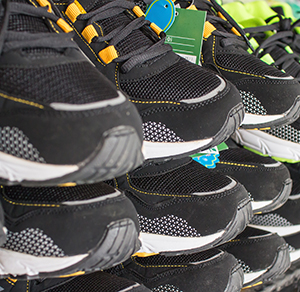Does the shoe fit?

It’s time for back to school shopping! Don’t forget the most important part of any student or athlete’s wardrobe is comfortable, proper-fitting, supportive shoes. Whether your child is competing in running sports or just being a kid on the playground, it is good to buy a well-fitting shoe for the activity. Poor-fitting shoes can result in blisters, bunions, calluses, pinched nerves, ingrown toenails, and corns. This is not how you or your child wants to start the new school year.
Feet grow constantly when kids are young, so they should have their feet measured every 3-6 months, and less often when they reach 16-18 years of age. But even adults need to have their feet measured as feet change shape with aging which may alter the shoe style needed. Also, different brands don’t necessarily fit the same. An eight in Nike might be a nine in Reebok. It is a must to try on every shoe before you purchase.
Try on multiple shoes and take your time. Bring the socks you or your child will wear and shoe shop later in the day when feet are more swollen. For runners, it is helpful to bring your old running shoes with you so that the salesperson can look at the wear pattern to determine the best shoe for you. Most people have one foot larger than the other, so buy shoes to fit the larger foot. Try to walk and even run in the shoes before deciding on a pair. Shoes should be comfortable from the start and not need any time to “break in or stretch.” They should have ample toe wiggle room — approximately one-half inch or more from great toe to the end of shoe. It’s best if the selected shoe be made of breathable fabrics such as leather or canvas and not synthetic materials. The forefoot of shoe should be flexible and bend as your foot naturally does when it pushes off the ground.
Shoes for kids can lace up or Velcro, but slip on styles should not be worn for running and sports. When participating in sports, shoes should not be made to multi-task. Running shoes are not appropriate for basketball or tennis and vice versa. It may be necessary to have several pair of shoes for different sports.
When shopping for running shoes, consider whether you are a runner or jogger on trails, asphalt, or a treadmill. If you land on your forefoot you may need a shoe with cushion in the front such as Nike Vomero. Conversely, if you are a heel-toe runner, Asics Gel Kayano is better with more cushion at the heel. Knowing foot type also helps. A flat, pronated foot may need a stability shoe and a foot with a high arch may need more cushioning to absorb shock on heel strike. Children usually have wider feet, so pay attention to width as well.
When shopping for kids shoes in particular, there are some bells and whistles to steer clear of. Shoes that light up may be fun but can be distracting to kids. Expect to pay more for celebrity-endorsed shoes. Don’t buy shoes based on appearance only, such as color. Fit and comfort should be the deciding factor. Avoid running shoes with large heel bump protruding from the heel as this may alter running mechanics and cause shin splints. Some things are worth paying a little more for such as extra cushioning, gel inserts, or air/spring shocks.
Injuries such as blisters, tendonitis, plantar fasciitis, or shin splints can be reversed with proper fitting running shoes. Changing the way you lace up shoes can also improve fit and comfort. For instance, straight bar lacing which pinching and pressure on the top of foot.
If you would like expert analysis and recommendations to help you select the equipment that best fits your body and exercise style, consider the Shoe Fit services available at the Sheltering Arms PT Works/West End Center.